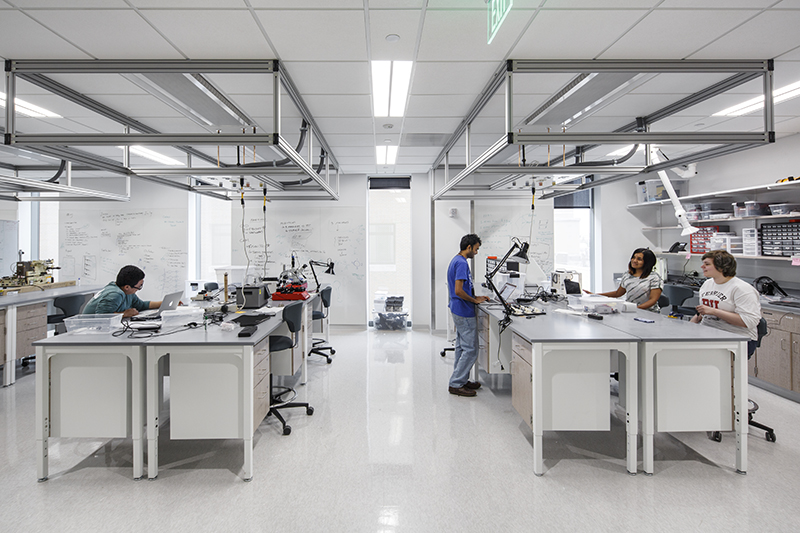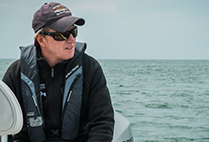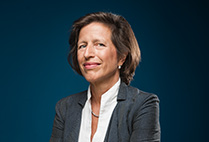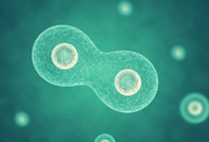By Barbara Moran
Xue Han comes to work each morning with an audacious goal: to cure Parkinson’s disease. The College of Engineering associate professor of biomedical engineering works in the field of optogenetics, in which scientists study nerve cells in the brain by using light to turn them on and off. Han is a neuroscientist, but to succeed, she needs engineers.
“Neuroscience is so interdisciplinary. There are so many engineers,” says Han, who notes that engineers are attracted to neuroscience for the complex instrumentation, the brain’s sophisticated electric circuitry, and the “big data” challenge. “If I look at my collaborators right now, many are electrical engineers,” she says. “That’s because we’re talking about artificial intelligence, deep learning, and because we have huge data. Neuroscience is generating data comparable to the scale of human genome data. Without electrical engineers, it will be impossible to solve the big data problem.”
Work like Han’s is the reason why the Rajen Kilachand Center for Integrated Life Sciences & Engineering exists. The new nine-story center represents an investment of a quarter of a billion dollars—a $135 million construction commitment from BU and a record $115 million gift from Rajen Kilachand (Questrom’74, Hon.’14). The center is designed to bring researchers together to solve problems that bridge disciplines, problems like Parkinson’s disease, hidden hearing loss, and antibiotic resistance. This focus on problems is key, says Susan Hockfield, president emerita of MIT and the first biologist (and first woman) to hold that position. During her tenure at MIT, Hockfield oversaw the opening of the Koch Institute for Integrative Cancer Research, which, like the Kilachand Center, gathered far-flung engineers and life scientists into one building. While she admits that she wasn’t sure at first whether the “convergence game” would work, she now says “it was more successful than I ever imagined.”

A melting pot for research: the Rajen Kilachand Center for Integrated Life Sciences & Engineering. Photos by Bob O’Connor
You say vector, I say…vector
When most people imagine the challenges of communication in science, they are thinking of scientists talking to the general public. But communication between disciplines can be just as challenging.
Daniel Segrè, a College of Arts & Sciences professor of biology and bioinformatics whose current work focuses on the human microbiome, sees this firsthand. And, with his educational background in physics, life sciences, and computational biology, he often lands in the role of translator. “Sometimes I sit in conversations and I realize there are two people talking to each other who don’t understand each other, and I can explain and mediate,” says Segrè. He says that he used to create different presentations about his work for different audiences, but now he tries to create a set of slides that works for everyone—and he urges his students to do the same. “I think it’s feasible,” he says. “I think a lot of people understand now that it’s really important. When we communicate science, we often talk to mixed audiences.”
“I see physics as kind of a desert where you’re looking for clean general statements about the world. And biology is like a jungle.”
–Daniel Segrè
Segrè notes that acronyms and jargon, which serve as shorthand within disciplines, can quickly confuse outsiders. (Unintentionally, one hopes.) “Jargon exists for a reason. It provides you a way of talking about incredibly complicated issues very quickly. Scientists get very uncomfortable moving out of that, because it feels like simplification,” says John Timmer, senior science editor at Ars Technica, who teaches communication skills to scientists through Alan Alda Center workshops. Timmer, who has a PhD in molecular and cellular biology, posted an article on Ars about the jargon problem a few years ago; so far, readers have posted more than 100 examples. “These are all familiar words that have technical meanings in fields, and I didn’t realize that they had any technical meaning, and then I also didn’t realize they had multiple ones,” says Timmer. “So it was a real eye-opener.”
For example, to an engineer, a “vector” is a quantity with both magnitude and direction; to a biologist, it’s something that spreads disease or delivers genetic material to a target cell. In life sciences, a “nucleus” contains a cell’s DNA; in physical sciences, a nucleus contains an atom’s protons and neutrons. Then there’s the word “expression.” Engineers think an expression is a mathematical equation; biologists think it’s the process of DNA transcription and translation; writers and artists think it means, well, writing and art.
Sometimes, even when researchers get the words right, they get the pronunciation wrong.
Douglas Densmore, an ENG associate professor of electrical and computer engineering, recalls an episode from his postdoc days. After receiving his PhD in electrical engineering, he spent three years as a postdoctoral fellow, designing synthetic biology software. It was his first foray into the squishy world of biology and bacteria, and he was a stranger in a strange land, trying to communicate with the natives in their own tongue. It didn’t always work.
“There’s an enzyme that’s responsible for DNA transcription—it finds a location in the DNA called the promoter, it attaches and turns it into an mRNA transcript,” explains Densmore. “The enzyme is called RNA polymerase, and I thought it was pronounced ‘polymer-asey.’” (As in, rhymes with daisy.) “And I remember the guy saying, ‘No, it’s polymer-aze.’”
“You have to be really humble,” he adds. “On any given day, I’m working with someone who has a PhD in a biological science. Unless I just drastically change my life, I’m not going to get a PhD in a biological science. So I think what’s really important is that I try to do what I do well, and try to learn.”
Physics is a desert, biology is a jungle
In addition to language challenges, there are cultural differences. Scientists and engineers, generally speaking, approach the world differently. Scientists want to understand how things work, and engineers want to solve problems. And, generally, biologists embrace—or at least accept—the chaos of nature, while engineers seek to harness it. “I see physics as kind of a desert where you’re looking for clean general statements about the world. And biology is like a jungle that is very messy with a lot of details,” says Segrè. “There is always this dichotomy. And I’m still fascinated by both.”
“You have to be really humble… what’s really important is that I try to do what I do well, and try to learn.”
–Douglas Densmore
The people attracted to interdisciplinary research, like Segrè, embrace the dichotomy, rather than flee it. But sometimes cultural stereotypes linger, says Catherine Klapperich, an ENG professor of biomedical engineering and associate dean for research at the College of Engineering. Klapperich is an engineer by training but regularly works with life scientists and physicians when creating tools for rapid disease diagnosis. Klapperich says she sometimes sees prejudice between fields. “Engineers will say, ‘It’s much easier to learn biology if you’re an engineer than to learn engineering if you’re a biologist,’” she says. “So that’s a prejudice that people in engineering have—that they know more math, and that you cannot just teach this math in a few courses; whereas an engineer could just go take three bio courses and know everything that a PhD biologist knows. Of course, this is not true, but people say that.”
“But in almost all cases,” she adds, “once engineers start working with life science colleagues, they build a quick and mutual respect for each others’ expertise.”
But even the willing, the motivated, and the humble can get frustrated while working between disciplines. Densmore, moving from the solid ground of electrical engineering to the shifting sands of biology, sometimes finds the uncertainty of the natural world disconcerting.
He recalls, as an undergrad, wiring up a taillight on a breadboard. “You made it, and it worked. You were never like, ‘I hope this works,’” he says. “You don’t flip the light switch and say, ‘I hope the lights come on.’ You know they’re going to come on because the circuit’s wired up. So that was my biggest challenge moving into biology—even when we built things, we weren’t sure if they were going to work. And that’s still a frustration to me, to this day.”

Photo by Bob O’Connor
“I think that’s what’s exciting, though,” says Densmore, who, like most researchers drawn to interdisciplinary work, finds it energizing and fun to work with people from different backgrounds. He also knows it’s often the best shot at solving big problems. “When you build a house, you get an electrician, a carpenter, an architect,” he says. “You get people who do different things, and the end result is greater than the sum of the parts.”
Allyson Sgro, an ENG assistant professor of biomedical engineering, echoes this sentiment. “Many of us come from very different backgrounds that aren’t purely biology or purely engineering, but we all were attracted to some facet of the life sciences,” says Sgro, whose background in chemistry and biophysics informs her work in multicellular communication. “I think that many of us were already doing what people would consider a mix of life sciences and engineering, and it’s fantastic to have this space that’s celebrating the intersection of these fields and what they will create together.”
















































Related Stories
Same Goals, Different Languages
BU’s largest gift brings life scientists and engineers together
New Kilachand Center Links Key Research Disciplines
Discoveries will be fueled by collaboration and a record $115 million gift
BU Scientists Attend Launch of National Microbiome Initiative
White House event announces federal, private sector collaboration
Post Your Comment